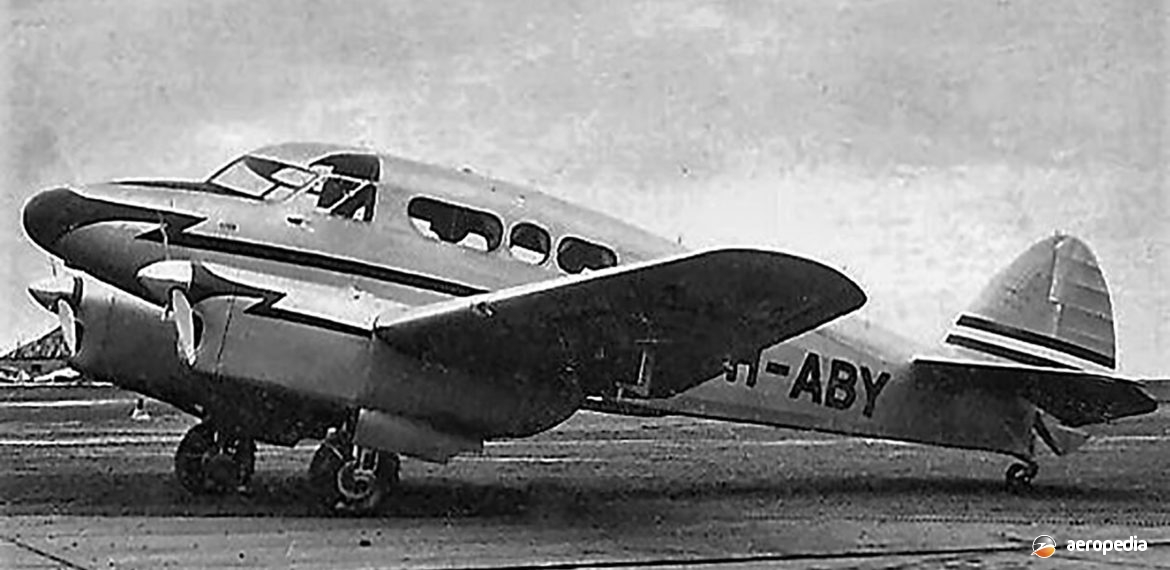Photograph:
Percival Q-6 VH-ABY (c/n Q.35) whilst operated by the Australian Department of Civil Aviation (CAHS collection)
Country of origin:
United Kingdom
Description:
Twin-engine business and executive monoplane
Power Plant:
Two 153 kw (205 hp) de Havilland Gipsy Six Series II six-cylinder in-line inverted air-cooled engines
Specifications:
- Wingspan: 14.26 m (46 ft 8 in)
- Length: 9.84 m (32 ft 3 in)
- Height: 3.01 m (9 ft 9 in)
- Wing area: 25.82 m² (278 sq ft)
- Max speed: 314 km/h (195 mph)
- Cruising speed at 2,134 m (7,000 ft) [retractable undercarriage]: 291 km/h (181 mph)
- Cruising speed [fixed undercarriage]: 277 km/h (172 mph)
- Landing speed with flaps: 93 km/h (58 mph)
- Initial rate of climb: 351 m/min (1,150 ft/min)
- Service ceiling: 6,401 m (21,000 ft)
- Ceiling on one engine: 1,981 m (6,500 ft)
- Endurance at cruising speed: 4 hours
- Range in still air: 1,207 km (750 miles)
- Empty weight: 1,588 kg (3,500 lb)
- Disposable load: 907 kg (2,000 lb)
- Loaded weight: 2,495 kg (5,500 lb)
History:
The Percival Q-6 was designed by Edgar Percival in about 1937 as a twin-engine monoplane with accommodation for four passengers in executive comfort and a crew of two powered by two Gipsy Six engines. The Q-6 fuselage was of plywood structure from the cabin aft with light fairing superstructure covered with plywood on the roof and fabric on the sides. The nose forward of the cabin was built up of light frames and stringers and covered with plywood. The wing was a cantilever type of all wood torsionally rigid structure with reinforced leading edge of plywood covering. Vacuum operated split flaps from aileron to aileron and under the fuselage were fitted. The Q-6 was available with a fixed or retractable undercarriage.
In all 27 examples were built (c/ns Q.20 to Q.46), of which seven were delivered to the RAF and given the service name Petrel. The prototype (G-AEYE – c/n Q.20) first flew at Luton, UK on 14 September 1937 in the hands of Edgar Percival. The first production aircraft (G-AFFD – c/n Q.21) was delivered to Sir Phillip Sassoon at Lympne in Kent on 2 March 1938. This machine was impressed by the RAF (as X9407) during World War II and later went to the Yorkshire Aeroplane Club (as G-AIEY). In 1947 it returned to its original registration before being retired in August 1956. It was for many years used as an instructional airframe at the Redhill College of Aeronautical Engineering and in the 1990s work commenced to restore it for static display for a museum.
This aircraft has had a number of owners over the years, all interested in restoring the aircraft to airworthiness. In October 2008 the project moved to Seething in Norfolk where Mr Rex Ford as trustee of the G-AFFD Restoration Group has been, with a group, restoring the aircraft to fly at some time in the future, this being the only survivor of the series. In recent references the Q-6 has been described as “The Learjet of its day, compact, fast, long-ranged and eye-catching: perfect for industrialists, aristocracy, governments and monarchs.”
Other examples were sold around the world, including one to France (F-AQOK – c/n Q.24), later serving with the Royal Navy as AX860, and one to King Ghazi of Iraq (YI-ROH – c/n Q.22). Two were supplied to the Lithuanian airline Lietuvos Linijos (LY-SOA – c/n Q.29; and LY-SOB – c/n Q.29).
Two Q-6s have an Australian connection. The first (VH-ABL – c/n Q.25) was ordered by P G [later Sir P G ‘Gordon’] Taylor in the late 1930s and the registration reserved. This was the first Q.6 with a retractable undercarriage and, after painting as VH-ABL, it went to Martlesham Heath in Suffolk for undercarriage trials in June 1938. However, it seems for reasons unknown the order was cancelled and the registration was not taken up, it was not imported, and the aircraft was registered to Percival Aircraft in the United Kingdom (G-AFMJ) following its first flight on 13 December 1938. In July 1939 it went to Vickers Armstrong Ltd; and in April 1940 it was impressed by the RAF (as X9594) but crashed at Castleton in Derbyshire on 10 September 1941.
The second (VH-ABY – c/n Q.35) was delivered to the Australian Civil Aviation Board in 1939 and was operated by the Board throughout the war years in the communications role. In August 1940 the Australian Minister for Air, the Hon J V Fairbairn, flew the aircraft to Darwin, NT and around Australia. On 1 July 1947 the aircraft was sold to one Wallace Stillard of Cobram, VIC but on 23 August was exchanged for a Waco and a Ryan with Mr J Meehan, a Geelong, VIC charter operator.
On 6 August 1947 on a flight from Sydney to Melbourne it disappeared. On board were the owner, Mr J Meehan, and Mr W Stillard. An intensive civil and military search was carried out, this including Consolidated B-24 Liberators and Bristol Beaufighters of the RAAF. The wreckage was located on 1 November 1948, the Q-6 having struck a mountain at 823 m (2,700 ft) above sea level, the surrounding mountains being up to 1,219 m (4,000 ft) in height, having crashed in a remote part of the Brindabella Ranges near Canberra, ACT, and was destroyed.

